
PRIORITY – Critical communication solutions
New solutions and technologies for public safety communications.
Branch: Digitalisation
Duration: 01.06.2019 – 31.12.2021
Region: National
Financed by: Business Finland
Project Manager: Marjut Koskela
Background
A major project PRIORITY will research, develop and trial critical communication solutions for authorities and remote businesses. A key target will be to complement existing mission critical voice and messaging services with broadband data capability, using commercial 4G and 5G wireless networks. The objective of the project is to improve the competitiveness of Finnish ecosystem of critical communications and situational awareness solutions.
Research topics will concentrate on four areas:
1) Broadband service availability in extremely remote locations
2) Quality of Service differentiation and provisioning for diverse needs
3) Communication security
4) Interworking of dedicated and commercial networks.
Project have several expected outcomes, where the most significant outcomes are technical solutions to be further developed into products in near future, new and evolved ecosystems in the area of critical communication, resulting in growing international business for the participants and the next capability level in safety authorities’ mission critical communication.
The project creates joint activities with many different actors in the field of critical communication. Project is part of Business Finland Digital Trust Finland program.
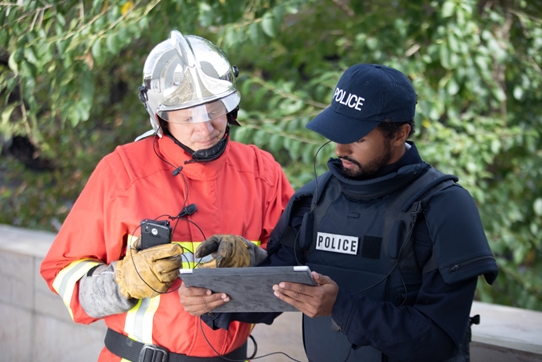
The significance of critical communication lies on one hand in the divergence of societal threats: for instance, cyberattacks, asymmetrical warfare and terrorism, as well as the climate change. On the other hand, developments in ICT technology, such as artificial intelligence, internet of things and 5G communication, create opportunities for completely new solutions, businesses and ecosystems in the field of critical communication.
So far public safety mission critical communications have been based on dedicated narrowband technologies, such as TETRA and Tetrapol. In the future, 5G mobile technologies will complement and replace them. This is not only a change of the wireless technology underneath but also a renewal of the whole Mission Critical PPDR Broadband ecosystem.
All topical ICT technologies will be involved in the transition consisting of smart devices and apps, analytics and AI, IoT, drones and many others. As we know, 5G will change societies more than the two previous-generation networks combined. Public Safety users such as police and rescue services have special requirements, which are beyond the requirements of consumers or enterprises.
These include high availability, reliability of services and uncompromised security, including protection against cyber security threats. Even though the solutions for public safety mission critical communications will be based on mainstream technologies, as such these are not enough due to very demanding requirements of reliability, security and high availability. The cooperative nature of the PRIORITY project will create new mission critical communication business ecosystems and support existing ones.
Priority will study future solutions for radio communication services that are critical for public safety and situational awareness. These put an emphasis on reliability and availability of the critical communication networks, in cities as well as in remote locations. Traficom will provide authority support and insights to the project.
PRIORITY consortium consists of 4 research partners as well as 13 companies and authorities. In collaboration with Centria University of Applied Sciences, the research parties include the University of Oulu, Turku University of Applied Sciences and VTT Technical Research Centre of Finland. Five companies of the consortium -Airbus, Bittium, Digita, Exfo, Keysight- have their own parallel industry projects ongoing. Other partners are the Finnish Transport and Communications Authority Traficom, The Finnish Defence Forces, Rescue services in Finland, Elisa, Erillisverkot, Fairspectrum, Verkotan and Central Union of Agricultural Producers and Forest Owners of Finland.
The solutions will be trialed in live network deployments, by applying the 5G-Force platform and scenario-specific technology blocks. Centria University of Applied Sciences test network in Ylivieska is part of 5G-Force platform for verifying the new 5G technology and for developing new features and vertical applications. Centria’s test network has a history since 2009 as a test platform for various enterprise and research-driven applications.
PRIORITY is researching and trialing Mission Critical Communications solutions for authorities and remote businesses. Project aims for advancement of Finnish Critical Communications Ecosystem. PRIORITY is a part of The Digital Trust Finland Program by Business Finland. Critical communications today must be prepared not only for typical authority operations, but also for major accidents, cyber-attacks, terrorism, pandemic or natural disasters brought by climate change. With international cooperation, it is possible to build the critical communications of different countries to work better together in broad cross-border emergencies.
The consortium for the project coordinated by the University of Oulu includes four other research partners: Centria University of Applied Sciences, VTT, Jyväskylä University of Applied Sciences and Turku University of Applied Sciences. Fifteen companies and authorities are also involved. Project partners include Airbus Defence and Space, Agco, Bittium, Digita, Exfo, Goodmill, Keysight, Transport and Communications Agency Traficom, Defence Force, Rescue, Elisa, Separate Networks, Fairspectrum, Verkotan and MTK ry ( Central Union of Agricultural Producers and Forest Owners).
Trial1
The key target is to create enablers for complementing existing Mission Critical Voice and messaging services with broadband data capability.
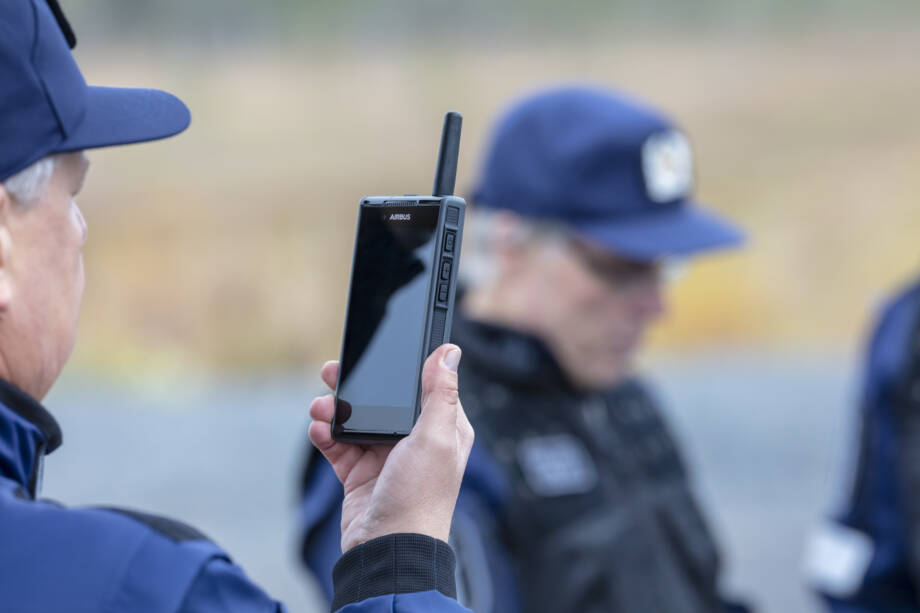
Photo: Tapio Mäkinen / Airbus.
The nationally and internationally significant PRIORITY project researches and tests new solutions for critical communication, security and remote connections between security authorities and companies. Critical communications today have to prepare not only for typical government operations but also for major disasters, cyber-attacks, terrorism, pandemics or natural disasters brought about by climate change.
The PRIORITY research project’s first trial was organized at the motorsport center OuluZone on 28 9. – 2.10.2020 to test the results of the research work carried out so far in the project. At OuluZone, critical communication situations were demonstrated by building a local 4G / 5G test network in the area and utilizing the latest communication technology and drones. The Finnish Transport and Communications Agency Traficom has been actively involved in the PRIORITY project: the frequency license received from Traficom made it possible to carry out the field tests. The test network utilized, among other things, the frequencies of the mobile operator Elisa within the framework of a frequency license granted by Traficom. The Finnish police, on the other hand, gave the permission to act as a police officer, who performs surveillance and alarm response in a Finnish operating environment, in the video production of the PRIORITY project filmed by NTRNZ Media. This was important for the field test scenario, as the police are a key security authority. During the testing event, a press conference was held where research institutes and collaborators presented critical communication technology and telecommunication use cases.
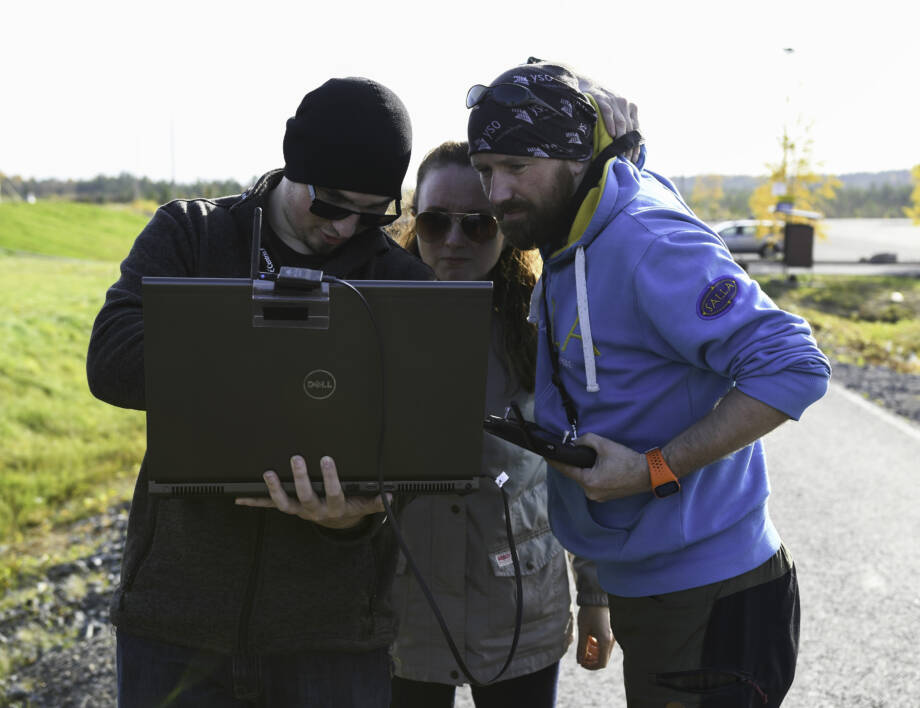
Centria’s project engineer Juha Erkkilä (left), RDI manager Marjo Heikkilä and development engineer Pentti Eteläaho are planning drone measurements of the local 4G / 5G test network in OuluZone. Photo: Marika Hautala.
Centria was actively involved in the design and implementation of the first trial of the PRIORITY project. The research team was responsible for integrating the tactical network functionalities related to the tactical network architecture and setting up the tactical bubble communications. Other responsibilities included drone control, transmission of the video image produced by the drone, thermal camera shots and measurements of the coverage area of the local test network, which are opened in more detail in the sections Drone control and image transfer via mobile phone network, as well as Quantitative and qualitative measurements of use cases. Centria also took responsibility for adapting the roles of the collaborators to the PRIORITY project’s critical communication research and trials.
The Future of Communication for Authorities
The Virve 2.0 project will provide more diverse and streamlined wireless broadband services to authorities and other mission critical operators. The Finnish public safety network (Virve) is a key communication system used by the authorities, which will reach the end of its technical life at the end of this decade. The modernization of the Virve network is needed, as the current system does not meet all the current requirements as it is based solely on the use of voice communications and short messages. New features are expected from the Virve terminal’s user interface, such as a more versatile group communication service and video transmission for communication between authorities and companies. The partner involved in the PRIORITY project, Suomen Erillisverkot Group, is responsible for Virve 2.0.
PRIORITY supports the Virve 2.0 project and produces important information for Erillisverkot about the possibilities of new technology in authority communications. The current Virve network is based on Airbus’ TETRA technology, in addition to which Airbus has supplied the terminals used in the Virve network and numerous network applications. In addition to Finland, Airbus has delivered critical communications solutions to more than 70 countries. Airbus Defense and Space Oy, a Finnish partner in the PRIORITY project, is developing new solutions based on 4G / 5G technology for critical communications. In the testing event of the PRIORITY project, e.g. Airbus’ Tactilon Agnet group communication service, which was used, among other things, for group speech and the transmission of video filmed by drones to field actors. In addition, Dabat hybrid terminals were used, which support existing TETRA networks as well as new broadband on the smartphone platform. Airbus terminals are being tested in all trials of the PRIORITY project.
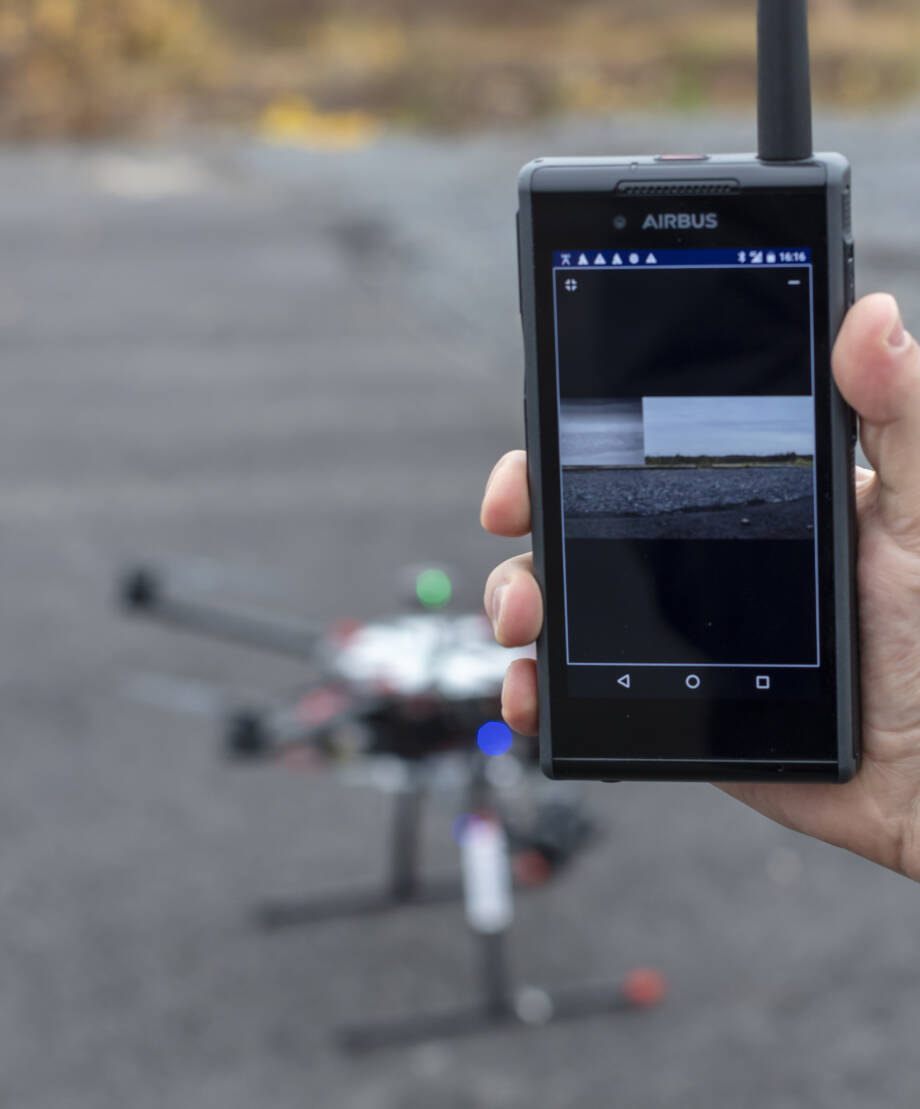
Airbus’ Tactilon Agnet group messaging service transmits the drone image to the Dabat hybrid terminal during a test event. Photo: Airbus / Tapio Mäkinen.
Elisa Corporation has been selected on the basis of a tender as the only radio network supplier in the Virve network, and Virve 2.0 subscriptions will use Elisa’s public mobile network. The new authority network service Virve 2.0 is based on broadband technology, which is made possible by Elisa’s mobile phone technology. Elisa plays a significant role in developing government communications so that broadband technology can meet the needs of authorities and companies. Elisa Corporation is also one of the partners in the PRIORITY project.
Utilization of a Tactical Mobile Network in Authority Communications
The tactical mobile network is part of the critical communication system being studied in the PRIORITY project. A tactical bubble refers to a temporary, static, or mobile radio resource built to support critical communications that provides the services needed for critical communications to the users in a variety of extreme conditions. A tactical bubble can be used to secure a broadband connection in emergency situations. Authorities or companies may need to operate in an area where mobile network coverage is weak, congested or, at worst, the target of a cyber-attack. The local voice service allows communication within the bubble even if the internet connection is lost.
A tactical bubble was built for the first trial of the PRIORITY project, which may contain several local cells. In OuluZone, the bubble consisted of two 4G cells as well as one 5G cell, which were connected to each other by a tactical wireless backbone network (Bittium TAC WIN), allowing for rapid cell transfer should the situation require it. The tactical bubble was connected to the Internet via a commercial 4G connection. Instead of a 4G connection, a broadband connection can also be brought into the area by expanding the wireless backbone network that connects the cells.
Centria, Bittium and EXFO in particular have become acquainted with mobile base stations for field conditions, which supplied the base stations for the PRIORITY project testing event. The construction of a local network in the OuluZone test area enabled the testing of more efficient telecommunication connections and the demonstration of concrete use scenarios. The first trial also tested the connection between the bubble and the mobile network.
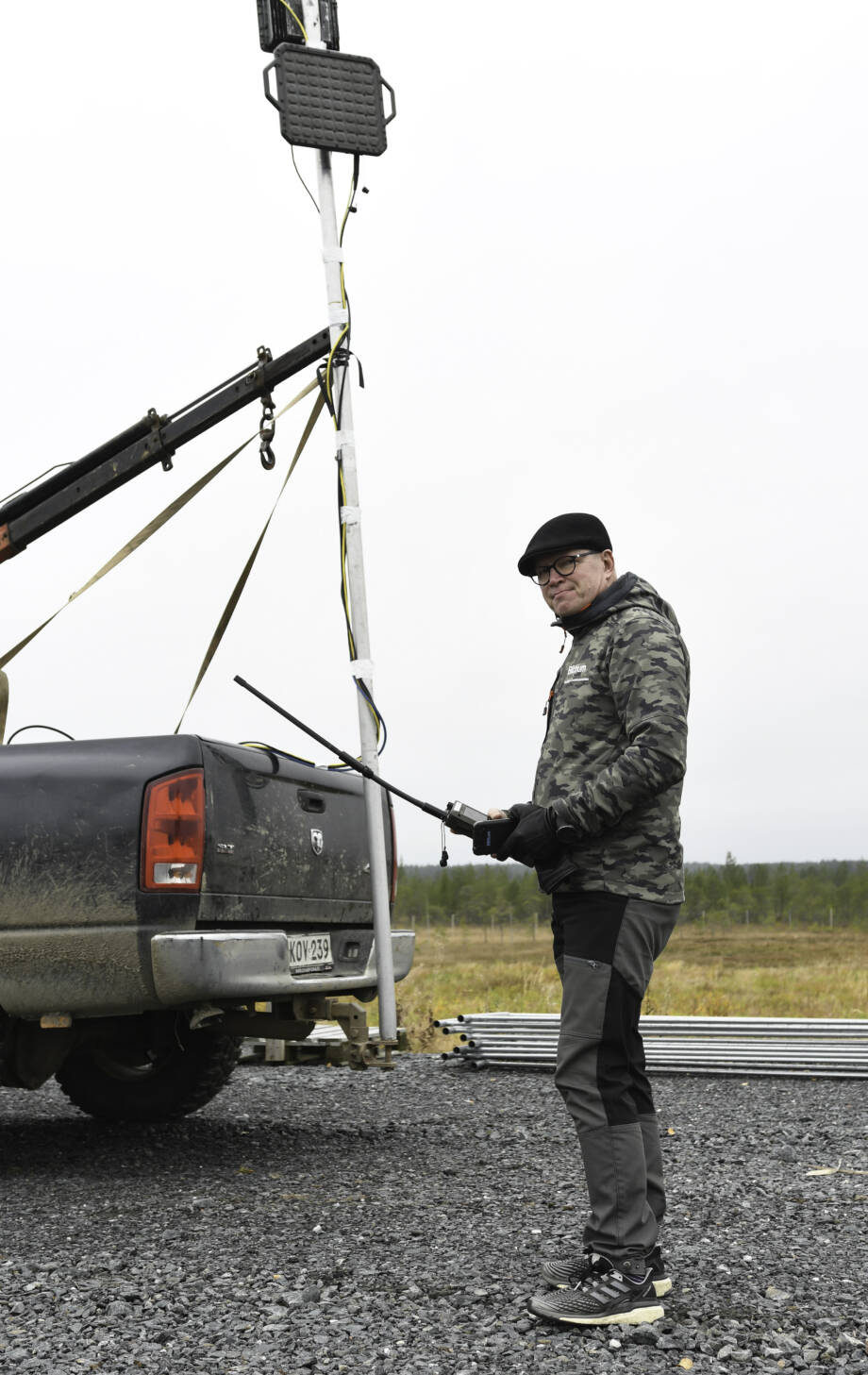
Systems expert Juha Kemppainen presenting Bittium’s tactical data transmission products and services. Photo: Marika Hautala.
Bittium Wireless Oy ‘s system expert Juha Kemppainen (Program Manager, Senior Specialist, System Architectures) and research and development manager Ari Hulkkonen (Senior Manager, Research and Technology) presented a tactical communication TAC WIN (Bittium Tactical Wireless IP Network) system developed by Bittium during the trial week of the PRIORITY project, which connected the local base stations of the tactical bubble with a high-speed wireless link. The setting up of the network and the associated mobile (vehicle-mounted) base station was demonstrated during field tests and a press conference. In addition to the local base stations, Bittium Tough SDR software radio equipment was connected to the TAC WIN network, which would allow, for example, the Defense Forces’ official assistance department to join the tactical Bubble. The solution presented by Bittium can be used to transmit and share a real-time snapshot of management systems (spatial information, image, sound, video, sensor data) between all authorities operating in a tactical bubble locally, to the defense networks as well as to the public telecommunications network, for example through a commercial 4G connection, which allows operations over a wide area. Bittium’s TAC WIN system and software radio equipment are widely used by the Defense Forces in their tactical data transmission applications.
– Our hardware is scalable and offers users network services from tactical systems to the commercial network, taking security into account. A distributed tactical voice and messaging service developed by Bittium is currently locally integrated into our tactical bubble. In addition, networked terminals are connected via an Internet connection to Airbus’ Tactilon Agnet group communication service used in government network, which acts as the main connection service in these field tests. The local voice and messaging service will be able to provide users with critical services, even if the connection to the Internet and services operating over it is lost, Hulkkonen said at the PRIORITY project trial.
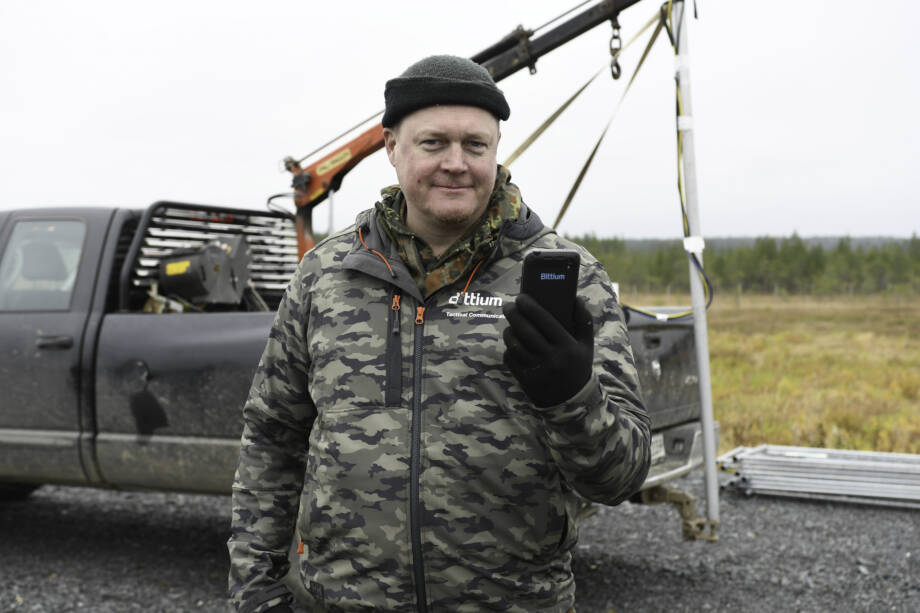
Research and Development Manager Ari Hulkkonen holds Bittium’s Tough Mobile, which enables certified data-secure broadband data transmission and speech in its area of operation. Photo: Marika Hautala.
Bittium sees the participation in the PRIORITY project as valuable, as the consortium’s versatile critical communication technologies are in common test use. -It is important to us to bond everyday technology and military technology together, to demonstrate the capability of the combination and to implement all the performance in the environment. Thanks to the official scenario of the trial, the compatibility of capabilities can be verified, Kemppainen describes the benefits of project cooperation. For Bittium, field tests of the equipment stock are commonplace.
Drone control and image transfer via mobile network
Centria’s drone and thermal imager utilized in the trial. In the picture on the right, right next to the stand, the Centria portable base station can be seen. Photo: Juha Erkkilä.
Drone technology is a strong area of expertise for Centria’s research team. During the first trial of the PRIORITY project, Centria was responsible for test flights related to drone image transfer and control, as well as thermal camera flights and their demonstration. During the first trial, it was tested how situational information can be transferred in real time to all actors in the field. The research team also performed cellular coverage measurements on the mobile phone network with drones.
Pentti Eteläaho, Centria’s development engineer, uses a thermal camera image to enhance situational awareness. Photo: Marjut Koskela.
Quantitative and qualitative measurements of use cases
Quantitative and qualitative evaluation are an important part of field testing. During the first trial of the PRIORITY project, quantitative coverage and delay measurements of use cases were carried out to study the coverage and data rate of the 4G / 5G test network. Trial’s quantitative and qualitative measurements are verifiable indicators that the critical communication technologies utilized during the PRIORITY project will work and the project’s objectives will be achieved. Authorities need to be able to rely on smooth data transfer at critical situations, and the critical communication objectives of a project are set from the perspective of user needs. Through real-world situations, telecommunications researchers’ study, among other things, the amount of data to be transmitted, the transmission speed, the transmission frequency, the transmission delay, the number of errors, the prioritization of data in relation to other data, and the security of data transmission.’
The PRIORITY project trial also carried out qualitative observation of use cases based on user experiences. The researchers, experts and collaborators who participated in the trial got acquainted with and tested the technologies used during the trial, after which they responded to the user survey based on the experience gained.
Centria conducted numerous measurements to assess the quality of service provided by the tactical bubble. Measurement data is displayed on the phone screen. Photo: Marika Hautala.
Keysight Technologies Finland Oy is one of the partners in the PRIORITY project, which specializes in measuring, testing and manufacturing navigation instruments and equipment. Keysight plays an active role in the trials of the project and the company is particularly interested in setting up a private network and validating its operations. – During the PRIORITY project, Keysight hopes to receive answers to what is required for the implementation of a separate bubble, what kind of service can be obtained through it, what practical problems may be noticed and what should be considered in specific use and deployment situations. An interesting collaborative project between companies and research organizations overall. It is new to me to be involved in such. It will be interesting to see how this collaboration works and to follow the enthusiasm of different actors in managing, developing and thinking about their own areas, says Eero Pulkkinen, Keysight’s Senior Product Manager, who is responsible for the post-processing and visualization of measurement results.
Keysight brings to the PRIORITY project expertise in the measurement of wireless networks and related software products, measuring devices and measurement software, as well as analysis software that can be used to examine the measured data in more depth. –Private networks and the way they are used, where authorities also need commercial technology services, are becoming important with 5G technology. Although the bubble is controlled by the authority, commercial technology is being utilized and the interface is very interesting. The biggest benefit for us from the project is seeing and observing the different uses and applications of critical communication. Through it, we learn a lot about what technology used in critical communication requires in practice, what kind of products are needed to measure such a network, and how we may need to be able to visualize the operation of the network and the measurement results afterwards. The different uses are those that provide additional information and enable us to perform sufficiently good analyzes and add value to users that use our software, says Pulkkinen.
Video production from the Priority project
In addition to the field tests, a video production of the three trial trials of the PRIORITY project will be produced, showing the trial-related critical communication scenarios and describing trials. Each trial has its own subject area, which are riot at a mass event, smart rural business, and a major disaster. The first trial told of a riot at a mass event, the scenes of which were filmed at the University of Oulu, in the city center of Oulu and at the motorsport center Oulu Zone.
Videoing a scene in which a field director directs a police patrol to act to catch the criminals. The polices are played by consortium specialists. Photo: Marika Hautala
The scenes from the scenarios of the first trial were mainly played by the members of the consortium. Additional help was also received from the Oulu Emergency Center, as an emergency response center officer was needed for the first trial. The aim was to select individuals who had held similar types of official positions during their lifetime. The purpose of the video production produced by the Oulu-based photography studio NTRNZ Media is to increase the visibility of the PRIORITY project, build the project’s image and disseminate the research results.
An emergency response center scene for the video production of the PRIORITY project was staged for the University of Oulu. Photo: Marika Hautala.
Trial2
Focus is on smart farming technologies, such as data transmission for remote control of the tractor, data collection from various sources, data visualization, the utilization of drones and AI, as well as rapidly deployable network traffic monitoring capabilities from the cyber security perspective.
One of the topics of PRIORITY project is Smart Rural Business where the aim is to increase the coverage of mobile network and data capacity for agriculture in remote areas.
In Agriculture and Forestry complementary telecommunications network solutions may be required to ensure opportunities that smart agriculture provides.
Focus is on intelligent agriculture technologies, such as data transmission for remote control of the tractor, data collection from various sources, data visualization, the utilization of drones and AI, as well as rapidly deployable network traffic monitoring capabilities from the cyber security perspective.
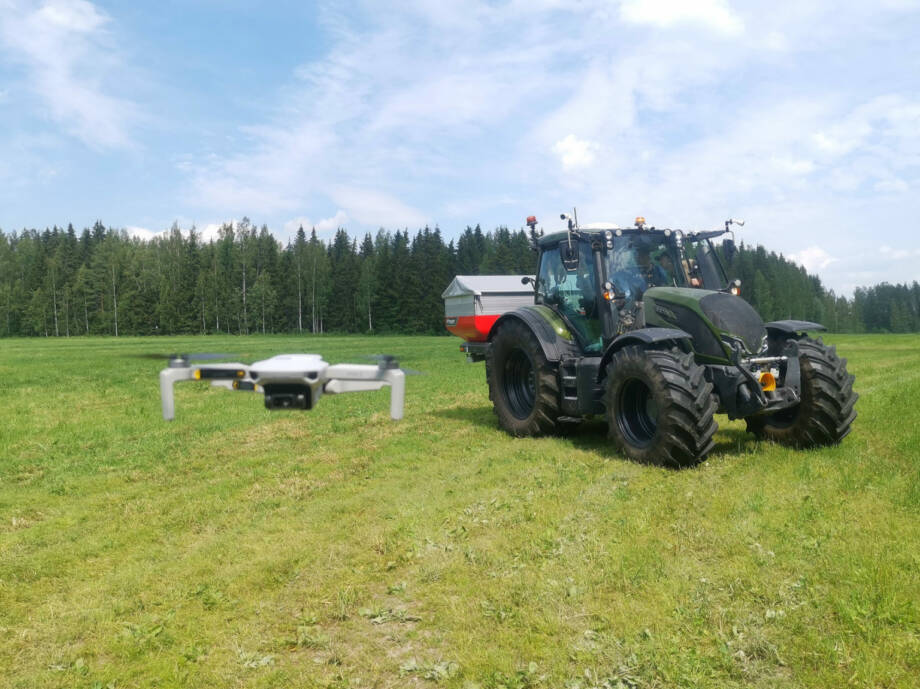
Trial3
An entity of private networks was built at the port area to support communication of the authorities in the event of a major accident. New critical communications solutions and cyber security technologies, a robot dog, chemical sensor, drones, body-cameras and remote control of a smart tractor were tested and demonstrated in the port area.
The Priority project researching critical communications for authorities held the final trial in the port area in early November 2021. An entity of private networks was built at the port area to support communication of the authorities in the event of a major accident. New critical communications solutions and cyber security technologies, a robot dog, chemical sensor, drones, body-cameras and remote control of a smart tractor were tested and demonstrated in the port area.
Scientific Publications
- Marjo Heikkilä, Pekka Koskela, Jani Suomalainen, Kalle Lähetkangas, Tero Kippola, Pentti Eteläaho, Juha Erkkilä, Ari Pouttu. Field trial with tactical bubbles for mission critical communications. Transactions on Emerging Telecommunications Technologies. Vol. 32, 2021. Wiley.https://dx.doi.org/10.1002/ett.4385
- Jani Suomalainen, Jukka Julku, Mikko Vehkaperä, Harri Posti. Securing Public Safety Communications on Commercial and Tactical 5G Networks: A Survey and Future Research Directions. IEEE Open Journal of the Communications Society. Vol. 2, pp. 1590-1615, 2021. IEEE.https://dx.doi.org/10.1109/OJCOMS.2021.3093529
- Jukka Julku, Jani Suomalainen, Markku Kylänpää. Delegated Device Attestation for IoT. Proceedings of the 8th International Conference on Internet of Things: Systems, Management and Security (IoTSMS 2021). IEEE. December 2021.
- Mikko Uitto & Antti Heikkinen. “Exploiting and Evaluating Live 360 Low Latency Video Streaming Using CMAF”, European Conference on Networks and Communications (EuCNC 2020), June 16-17, 2020.
- Mikko Vehkaperä et al. “Testbed for Local-Area Private Network with Satellite-Terrestrial Backhauling”, The Third International Conference on Electrical, Communication and Computer Engineering (ICECCE 2021), June 12–13, 2021.
- Mikko Uitto et al. “Evaluation of Live Video Streaming Performance for Low Latency Use Cases in 5G”, European Conference on Networks and Communications (EuCNC 2021), June 8-11, 2021
- Jani Suomalainen et al. “Machine Learning Threatens 5G Security”, IEEE Access, vol. 8, pp. 190822-190842, October 19, 2020.
- Marjo Heikkilä. Contribution to 6G white papers “6G White Paper on Connectivity for Remote Areas” and “6G White Paper on Validation and Trials for Verticals towards 2030’s” , 2nd 6G summit, 4/2020, online:https://www.6gchannel.com/items/6g-white-paper-connectivity-remote-areas/ and https://www.6gchannel.com/items/6g-white-paper-validation-trials/
- Marjo Heikkilä et al. “Unmanned Agricultural Tractors in Private Mobile Networks”, December 30, 2021, online: Network | Free Full-Text | Unmanned Agricultural Tractors in Private Mobile Networks (mdpi.com)
Popular articles
Trial 3
- Talouselämä 21.11.2021 Robottikoira hoiti nuuskimisen suuronnettomuusharjoituksessa Oulussahttps://www.talouselama.fi/uutiset/robottikoira-hoiti-nuuskimisen-suuronnettomuusharjoituksessa-oulussa/ab
- Kauppalehti 21.11.2021 Oulussa harjoiteltiin suuronnettomuustilannetta – Mukana drooneja ja robottikoiraOulussa harjoiteltiin suuronnettomuustilannetta – Mukana drooneja ja robottikoira | Kauppalehti
- Osto&Logistikka 19.11.2021 Uutta viranomaisverkkoa testattiin suuronnettomuusharjoituksen yhteydessä Uutta viranomaisverkkoa testattiin suuronnettomuusharjoituksen yhteydessä – Osto&Logistiikka (ostologistiikka.fi)
- Taloussanomat 15.11.2021 : Uutta viranomaisverkkoa testattiin suuronnettomuusharjoituksen yhteydessä Lehdistötiedote – Taloussanomat – Ilta-Sanomat
- Uusiteknologia: 15.11.2021. Uusi viranomaisverkko testissä – mukana etäohjattava robottikoirahttps://www.uusiteknologia.fi/2021/11/15/uusi-viranomaisverkko-testissa-mukana-etaohjattavia-robottikoiria/
- Tivi: 15.11.2021. Robottikoira hoiti nuuskimisen suuronnettomuusharjoituksessahttps://www.tivi.fi/uutiset/tv/3606f383-eef5-41ea-bc40-d517d96befcd
- Centria-ammattikorkeakoulu 15.11.2021 : Suuronnettomuusharjoituksen yhteydessä testattiin uutta liikuteltavaa viranomaisverkkoa CentriaTKI | PRIORITY
- Oulun yliopisto 15.11.2021Uutta viranomaisverkkoa testattiin suuronnettomuusharjoituksen yhteydessä | Oulun yliopisto (sttinfo.fi)
- Oulun yliopisto 15.11.2021Uutta viranomaisverkkoa testattiin suuronnettomuusharjoituksen yhteydessä | Oulun yliopisto
Trial 2
- Uusiteknologia 18.11.2021 Maatalouteen robotiikan lisäksi langatonta tekniikkaa – Uusiteknologia.fi
- Centria Bulletin 1.11.2021 Uudet älymaatalouden teknologiat testikentällä (centriabulletin.fi)
- Oulun yliopisto 10.8.2021 Älykkään maatalouden teknologioita testattiin Saarijärven Biotalouskampuksella | Oulun yliopisto
- Sampo 30.6. 2021. Lehtiartikkeli: Älymaatila on pian täyttä totta missä päin vain.
- Maaseudun tulevaisuus 29.6.2021. Artikkeli: “Ruuantuotanto on yhteiskunnan kriittinen ala” – hankkeen yhtenä tutkimuskohteena älymaatalous – Maatalous – Maaseudun Tulevaisuus
- Maaseudun tulevaisuus 28.6.2021 Lehtiartikkeli. Viljeliäkin voi siirtyä etätyöhön etäohjattavilla traktoreilla.
- Ammattilehti 28.6. Artikkeli: Älykkään maatalouden teknologioita testattiin Saarijärvellä | ammattilehti.fi
- Maaseudun tulevaisuus 28.6.2021 Artikkeli: Video: Näin kulkee tulevaisuuden traktori – viljelijäkin voi siirtyä etätyöhön etäohjattavilla traktoreilla – Maatalous – Maaseudun Tulevaisuus
- Tekniikka ja talous 28.6.2021 Verkkoartikkeli: Tulevaisuuden farmari voi etäohjata traktoriaan 5g-verkon yli – tällä viikolla sitä on testattu Saarijärvellä | Tekniikkatalous
- Uusiteknologia 28.6. 2021 Verkkoartikkeli: Traktoriin etäohjaus 5G-verkon kautta – dronetavuksi – Uusiteknologia.fi
- Jyväskylän ammattikorkeakoulu 28.6.2021 Älykkään maatalouden teknologioita testattiin Saarijärven Biotalouskampuksella – JAMK
- Pohjoisen Keski-Suomen ammattiopisto 21.6.2021 Biotalouskampuksella käynnistyy älymaatalouden testiviikko – poke.fi
- Oulun yliopisto 8.6.2021 Älykkään maatalouden teknologioita testattiin Saarijärven Biotalouskampuksella – JAMK
- Jyväskylän ammattikorkeakoulun asiakaslehti 1/2021. Artikkeli: Biotalouskampuksella hypättiin älymaatalouden eturiviin: Biotalouskampuksella hypättiin älymaatalouden eturiviin – JAMK
- Oulun yliopisto: Älykkään maatalouden teknologioita testattiin Saarijärven Biotalouskampuksella | Oulun yliopisto
- Oulun yliopisto: Mediakutsu: Älykkään maatalouden teknologioita testataan Saarijärven Biotalouskampuksella | Oulun yliopisto (sttinfo.fi)
Trial1
- Airbus. ”Airbus chairs Finnish Priority research program for innovation”, 15.10.2019, online: https://www.securelandcommunications.com/en-press-releases/airbus-businessfinland-priority-program-consortium-innovation-5g
- Erillisverkot 28.9.2020 Lehdistötiedote:https://www.erillisverkot.fi/erillisverkot-mukana-priority-hankkeen-tulevaisuuden-viranomaisverkkoratkaisujen-demonstroinnissa-28-9-2-10-20-oulussa/
- Kaleva 2.10.2020 Artikkeli: https://www.kaleva.fi/taktinen-kupla-testattavana-ouluzonessa-siirrettav/2955238
- ”Centria mukana kehittämässä uuden polven viranomaisviestintää – Taktisella kuplalla turvataan laajakaista poikkeusoloissa”, Kalajokilaakso 4.10.2020, online: https://www.kalajokilaakso.fi/uutinen/602433
- Airbus. ”Airbus demonstrates progress made in the PRIORITY innovation research program”, Press release, 5.10.2020, online:https://www.securelandcommunications.com/en-press-releases/airbus-demonstrates-progress-priority-innovation-research-program
- Tekniikka ja talous 23.10.2020 Artikkeli: Taktinen kupla tuo laajakaistan viranomaisille(katso liite)
- Erillisverkot; Erve uutiset. ”Taktisen kuplan avulla viranomaisverkko liikkuu hankaliinkin paikkoihin”, Web article, 26.10.2020, online: https://www.erillisverkot.fi/taktisen-kuplan-avulla-viranomaisverkko-liikkuu-hankaliinkin-paikkoihin/
- Tekniikka ja talous 29.10.2020 Verkkoartikkeli: Taktinen kupla tuo tulevaisuudessa laajakaistaverkon sinne, minne viranomainen haluaa sen tulevan – tästä on kyse https://www.tekniikkatalous.fi/uutiset/taktinen-kupla-tuo-tulevaisuudessa-laajakaistaverkon-sinne-minne-viranomainen-haluaa-sen-tulevan-tasta-on-kyse/9502d8ff-7fd0-4b66-a76e-4023aa7822e6
- TAMK. Talk-verkkolehti ”5G – missä mennään?”, Web article, 2.11.2020, online: https://talk.turkuamk.fi/digitalisaatio/5g-missa-mennaan/
- ”Oma 5g-verkko pystyyn minuutissa – viranomaisille kehitetään taktista kuplaa”, Tietoviikko, 23.11.2020, online: https://www.tivi.fi/uutiset/oma-5g-verkko-pystyyn-minuutissa-viranomaisille-kehitetaan-taktista-kuplaa/701e3c24-f25e-4d5a-a90c-8256d3ce4df4
- Centria Bulletin –verkkolehti 10.11.2020 Artikkeli: Uudet teknologiat viranomaisviestinnän käyttöön https://centriabulletin.fi/uudet-teknologiat-viranomaisviestinnan-kayttoon/
- TiVi Marraskuu 2020 Verkkoartikkeli: Oma 5g-verkko pystyyn minuutissa – viranomaisille kehitetään taktista kuplaa https://www.tivi.fi/uutiset/oma-5g-verkko-pystyyn-minuutissa-viranomaisille-kehitetaan-taktista-kuplaa/771546a4-cdc3-4a0f-b664-aaaa69bb217e
- ”Taktinen kupla testattavana OuluZonessa – siirrettävä 5G-tukiasema voi hyödyttää viranomaisia”, Kaleva 2.10.2020, online: https://www.kaleva.fi/taktinen-kupla-testattavana-ouluzonessa-siirrettav/2955238
- ”Uusia ratkaisuja viranomaisten viestintään”, Pelastustieto 2/2020.
- ”5G-teknologia tulee myös viranomaisten avuksi – saako taivaalta droonikuvaa suorana?”, YLE news, online: https://yle.fi/uutiset/3-11060861
- Oulun yliopiston uusi projekti tutkii ja kehittää kriittistä viranomaisviestintää – tavoitteena hyödyntää 5G-verkkoja”, Kaleva 10.10.2019, online: https://www.kaleva.fi/uutiset/oulu/oulun-yliopiston-uusi-projekti-tutkii-ja-kehittaa-kriittista-viranomaisviestintaa-tavoitteena-hyodyntaa-5g-verkkoja/828215/
- Ijaz Ahmad, Jani Suomalainen, Jyrki Hussko. “5G Core Network Security”, Wiley 5G Ref: The Essential 5G Reference, 30.9.2019,online: https://onlinelibrary
Latest News
Project Alpha will create new innovations to ensure national security
The aim of the Project Alpha, which is of national and international significance, is to create new knowledge, expertise and new shared innovations for identifying hybrid threats as well as for forming situational awareness to guarantee the safety of citizens and authorities.
Smart Agriculture technologies were tested on the Saarijärvi Bioeconomy Campus
Centria coordinates a total of three trials during the PRIORITY project.
A trial related to Smart Agriculture is being prepared
The second trial of the PRIORITY project will focus on Smart Rural Business, which aims to increase the vitality and attractiveness of remote areas.
The size of the PRIORITY consortium increased with three major partners
The consortium of the PRIORITY project was supplemented by one research institute and two business partners.
A video of the scenarios for the first trial has now been released
The research results of the PRIORITY project will be presented in three trials, which will show critical communication scenarios and describe field testing.